turn signal BMW 528I 2013 Owners Manual
[x] Cancel search | Manufacturer: BMW, Model Year: 2013, Model line: 528I, Model: BMW 528I 2013Pages: 246, PDF Size: 5.39 MB
Page 13 of 246

Front fog lamps‚Äā‚ÄÖ97Parking lamps‚Äā‚ÄÖ94Low beams‚Äā‚ÄÖ94Automatic headlamp con‚Äź
trol‚Äā‚ÄÖ 95
Daytime running lights‚Äā‚ÄÖ 95
Adaptive Light Control‚Äā‚ÄÖ 96
High-beam Assistant‚Äā‚ÄÖ 96Instrument lighting‚Äā‚ÄÖ988Steering column stalk, leftTurn signal‚Äā‚ÄÖ69High beams, head‚Äź
lamp flasher‚Äā‚ÄÖ 69High-beam Assistant‚Äā‚ÄÖ 96Roadside parking lamps‚Äā‚ÄÖ 95Computer‚Äā‚ÄÖ889Shift paddles‚Äā‚ÄÖ 7410Steering wheel buttons, leftStore speed‚Äā‚ÄÖ132‚Äā‚ÄÖ126Resume speed‚Äā‚ÄÖ 134‚Äā‚ÄÖ128Cruise control on/off, interrupt‚Äź
ing‚Äā‚ÄÖ 126Cruise control on/off, interrupt‚Äź
ing‚Äā‚ÄÖ 132Increase distance‚Äā‚ÄÖ 128Reduce distance‚Äā‚ÄÖ128Cruise control rocker switch‚Äā‚ÄÖ 133,‚Äā‚ÄÖ12711Instrument cluster‚Äā‚ÄÖ 7512Steering wheel buttons, rightEntertainment sourceVolumeVoice activation‚Äā‚ÄÖ22Phone, see user's manual for Nav‚Äź
igation, Entertainment and Com‚Äź
munication.Thumbwheel for selection lists‚Äā‚ÄÖ 8813Steering column stalk, rightWindshield wipers‚Äā‚ÄÖ69Rain sensor‚Äā‚ÄÖ70Clean the windshields and head‚Äź
lamps‚Äā‚ÄÖ 6914Start/stop the engine and switch
the ignition on/off‚Äā‚ÄÖ 63Auto Start/Stop function‚Äā‚ÄÖ 6415Horn16Steering wheel heating‚Äā‚ÄÖ5717Steering wheel adjustment‚Äā‚ÄÖ 57Seite 13CockpitAt a glance13
Online Edition for Part no. 01 40 2 917 522 - II/13
Page 33 of 246
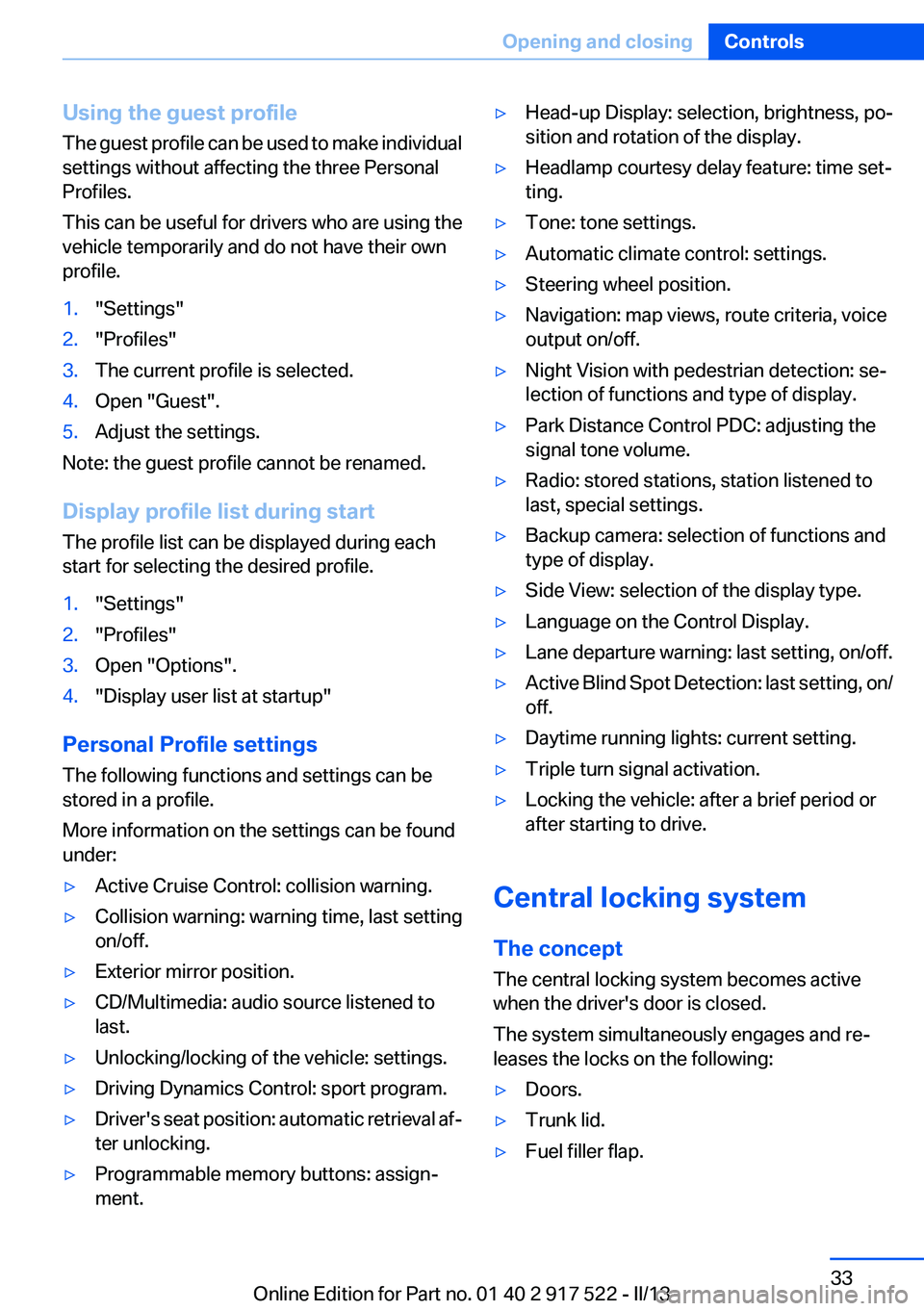
Using the guest profile
The guest profile can be used to make individual
settings without affecting the three Personal
Profiles.
This can be useful for drivers who are using the
vehicle temporarily and do not have their own
profile.1."Settings"2."Profiles"3.The current profile is selected.4.Open "Guest".5.Adjust the settings.
Note: the guest profile cannot be renamed.
Display profile list during start
The profile list can be displayed during each
start for selecting the desired profile.
1."Settings"2."Profiles"3.Open "Options".4."Display user list at startup"
Personal Profile settings
The following functions and settings can be
stored in a profile.
More information on the settings can be found
under:
‚Ė∑Active Cruise Control: collision warning.‚Ė∑Collision warning: warning time, last setting
on/off.‚Ė∑Exterior mirror position.‚Ė∑CD/Multimedia: audio source listened to
last.‚Ė∑Unlocking/locking of the vehicle: settings.‚Ė∑Driving Dynamics Control: sport program.‚Ė∑Driver's seat position: automatic retrieval af‚Äź
ter unlocking.‚Ė∑Programmable memory buttons: assign‚Äź
ment.‚Ė∑Head-up Display: selection, brightness, po‚Äź
sition and rotation of the display.‚Ė∑Headlamp courtesy delay feature: time set‚Äź
ting.‚Ė∑Tone: tone settings.‚Ė∑Automatic climate control: settings.‚Ė∑Steering wheel position.‚Ė∑Navigation: map views, route criteria, voice
output on/off.‚Ė∑Night Vision with pedestrian detection: se‚Äź
lection of functions and type of display.‚Ė∑Park Distance Control PDC: adjusting the
signal tone volume.‚Ė∑Radio: stored stations, station listened to
last, special settings.‚Ė∑Backup camera: selection of functions and
type of display.‚Ė∑Side View: selection of the display type.‚Ė∑Language on the Control Display.‚Ė∑Lane departure warning: last setting, on/off.‚Ė∑Active Blind Spot Detection: last setting, on/
off.‚Ė∑Daytime running lights: current setting.‚Ė∑Triple turn signal activation.‚Ė∑Locking the vehicle: after a brief period or
after starting to drive.
Central locking system
The concept
The central locking system becomes active
when the driver's door is closed.
The system simultaneously engages and re‚Äź
leases the locks on the following:
‚Ė∑Doors.‚Ė∑Trunk lid.‚Ė∑Fuel filler flap.Seite 33Opening and closingControls33
Online Edition for Part no. 01 40 2 917 522 - II/13
Page 67 of 246
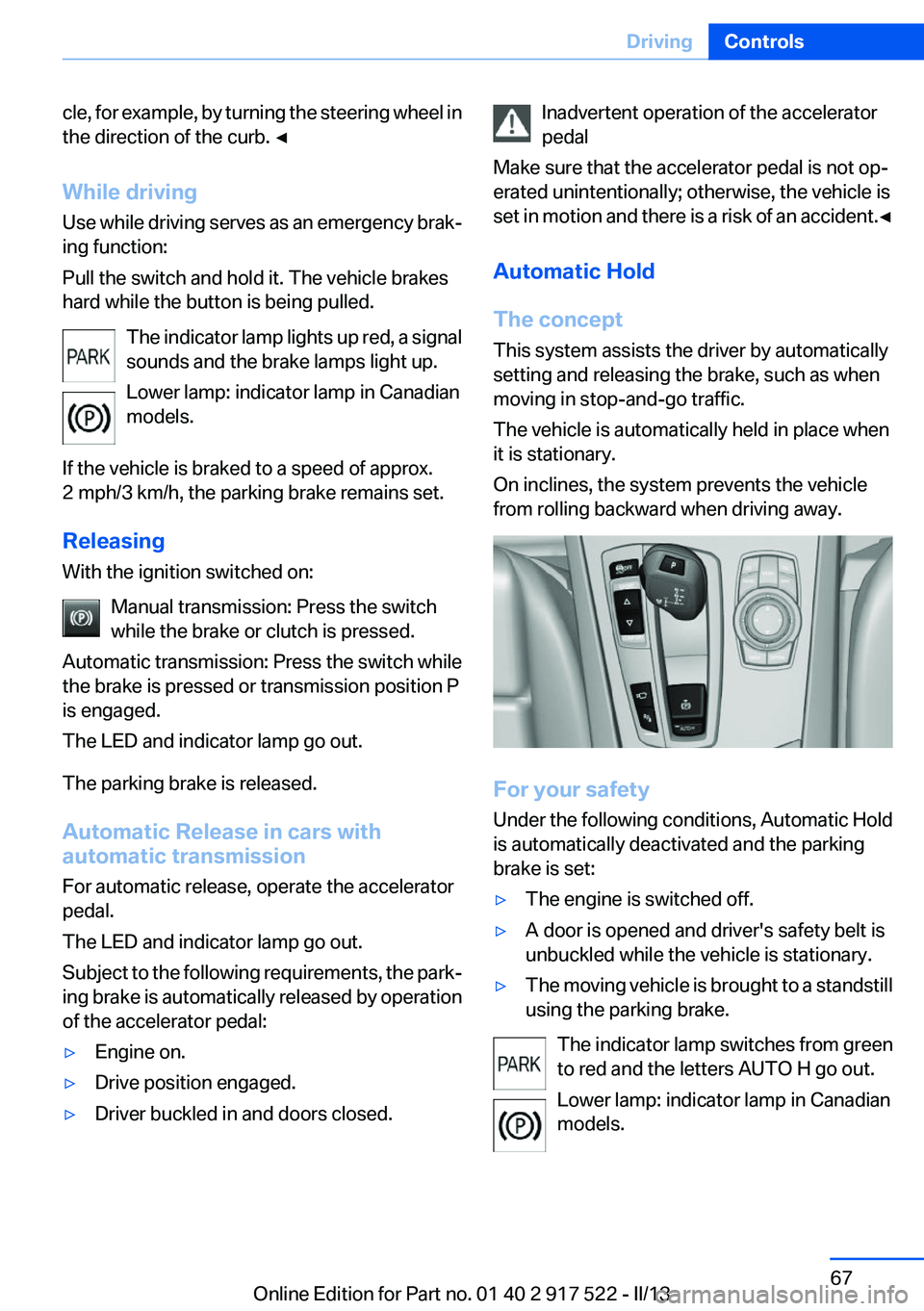
cle, for example, by turning the steering wheel in
the direction of the curb. ‚óÄ
While driving
Use while driving serves as an emergency brak‚Äź
ing function:
Pull the switch and hold it. The vehicle brakes
hard while the button is being pulled.
The indicator lamp lights up red, a signal
sounds and the brake lamps light up.
Lower lamp: indicator lamp in Canadian
models.
If the vehicle is braked to a speed of approx.
2 mph/3 km/h, the parking brake remains set.
Releasing
With the ignition switched on:
Manual transmission: Press the switch
while the brake or clutch is pressed.
Automatic transmission: Press the switch while
the brake is pressed or transmission position P
is engaged.
The LED and indicator lamp go out.
The parking brake is released.
Automatic Release in cars with
automatic transmission
For automatic release, operate the accelerator
pedal.
The LED and indicator lamp go out.
Subject to the following requirements, the park‚Äź
ing brake is automatically released by operation
of the accelerator pedal:‚Ė∑Engine on.‚Ė∑Drive position engaged.‚Ė∑Driver buckled in and doors closed.Inadvertent operation of the accelerator
pedal
Make sure that the accelerator pedal is not op‚Äź
erated unintentionally; otherwise, the vehicle is
set in motion and there is a risk of an accident. ‚óÄ
Automatic Hold
The concept
This system assists the driver by automatically
setting and releasing the brake, such as when
moving in stop-and-go traffic.
The vehicle is automatically held in place when
it is stationary.
On inclines, the system prevents the vehicle
from rolling backward when driving away.
For your safety
Under the following conditions, Automatic Hold
is automatically deactivated and the parking
brake is set:
‚Ė∑The engine is switched off.‚Ė∑A door is opened and driver's safety belt is
unbuckled while the vehicle is stationary.‚Ė∑The moving vehicle is brought to a standstill
using the parking brake.
The indicator lamp switches from green
to red and the letters AUTO H go out.
Lower lamp: indicator lamp in Canadian
models.
Seite 67DrivingControls67
Online Edition for Part no. 01 40 2 917 522 - II/13
Page 69 of 246
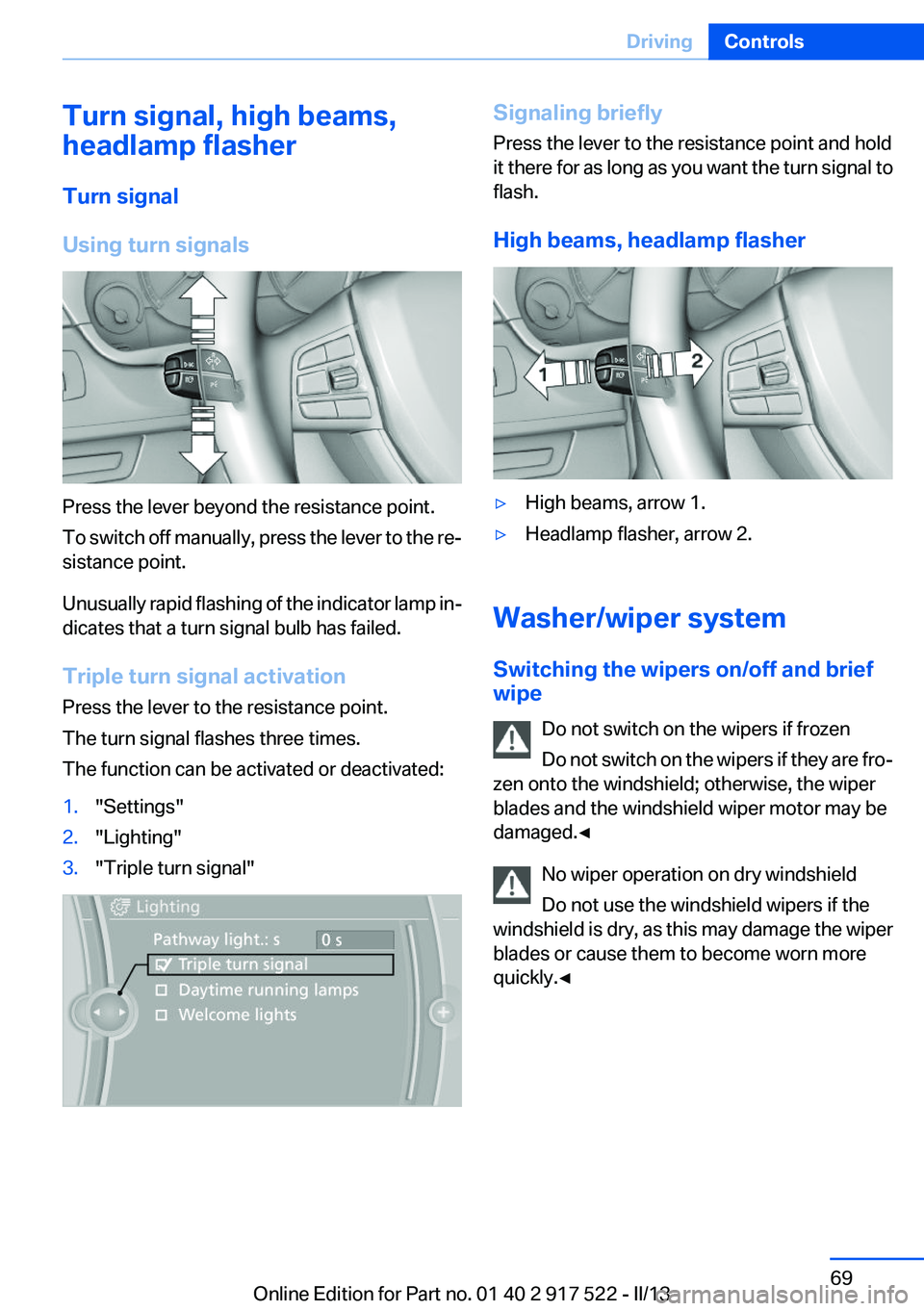
Turn signal, high beams,
headlamp flasher
Turn signal
Using turn signals
Press the lever beyond the resistance point.
To switch off manually, press the lever to the re‚Äź
sistance point.
Unusually rapid flashing of the indicator lamp in‚Äź
dicates that a turn signal bulb has failed.
Triple turn signal activation
Press the lever to the resistance point.
The turn signal flashes three times.
The function can be activated or deactivated:
1."Settings"2."Lighting"3."Triple turn signal"Signaling briefly
Press the lever to the resistance point and hold
it there for as long as you want the turn signal to
flash.
High beams, headlamp flasher‚Ė∑High beams, arrow 1.‚Ė∑Headlamp flasher, arrow 2.
Washer/wiper system
Switching the wipers on/off and brief
wipe
Do not switch on the wipers if frozen
Do not switch on the wipers if they are fro‚Äź
zen onto the windshield; otherwise, the wiper
blades and the windshield wiper motor may be
damaged.‚óÄ
No wiper operation on dry windshield
Do not use the windshield wipers if the
windshield is dry, as this may damage the wiper
blades or cause them to become worn more
quickly.‚óÄ
Seite 69DrivingControls69
Online Edition for Part no. 01 40 2 917 522 - II/13
Page 82 of 246
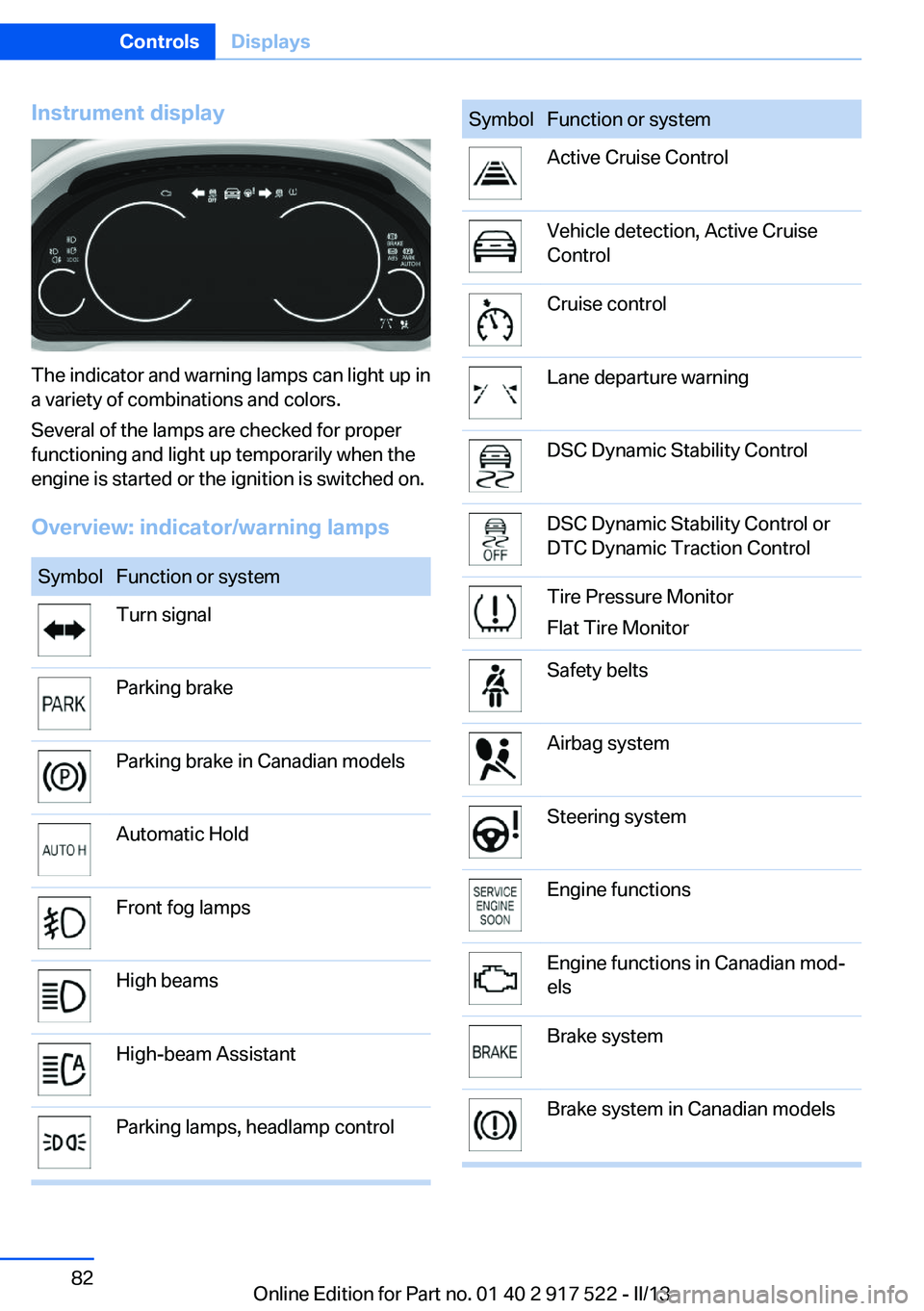
Instrument display
The indicator and warning lamps can light up in
a variety of combinations and colors.
Several of the lamps are checked for proper
functioning and light up temporarily when the
engine is started or the ignition is switched on.
Overview: indicator/warning lamps
SymbolFunction or systemTurn signalParking brakeParking brake in Canadian modelsAutomatic HoldFront fog lampsHigh beamsHigh-beam AssistantParking lamps, headlamp controlSymbolFunction or systemActive Cruise ControlVehicle detection, Active Cruise
ControlCruise controlLane departure warningDSC Dynamic Stability ControlDSC Dynamic Stability Control or
DTC Dynamic Traction ControlTire Pressure Monitor
Flat Tire MonitorSafety beltsAirbag systemSteering systemEngine functionsEngine functions in Canadian mod‚Äź
elsBrake systemBrake system in Canadian modelsSeite 82ControlsDisplays82
Online Edition for Part no. 01 40 2 917 522 - II/13
Page 83 of 246
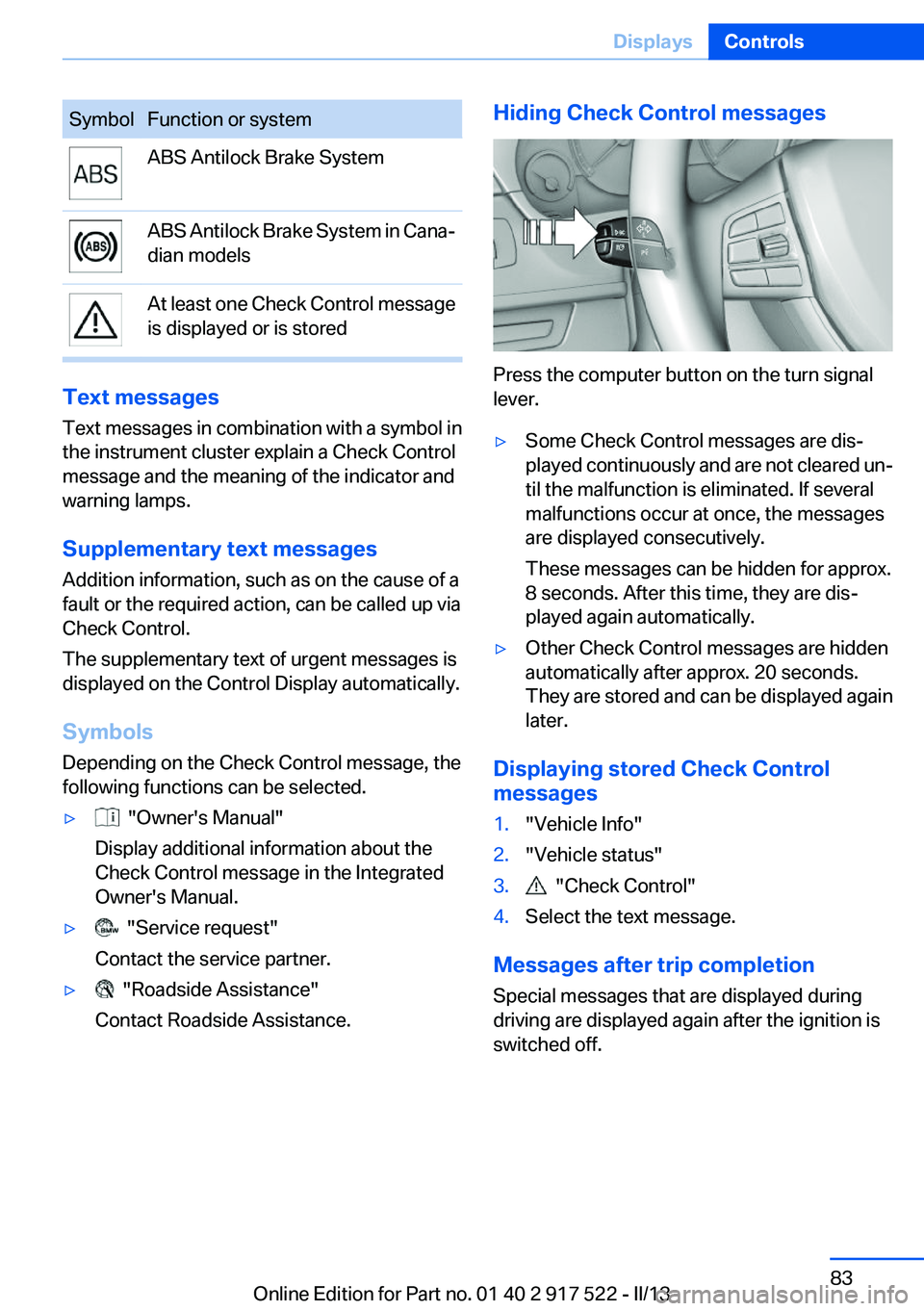
SymbolFunction or systemABS Antilock Brake SystemABS Antilock Brake System in Cana‚Äź
dian modelsAt least one Check Control message
is displayed or is stored
Text messages
Text messages in combination with a symbol in
the instrument cluster explain a Check Control
message and the meaning of the indicator and
warning lamps.
Supplementary text messages
Addition information, such as on the cause of a
fault or the required action, can be called up via
Check Control.
The supplementary text of urgent messages is
displayed on the Control Display automatically.
Symbols
Depending on the Check Control message, the
following functions can be selected.
‚Ė∑ "Owner's Manual"
Display additional information about the
Check Control message in the Integrated
Owner's Manual.‚Ė∑ "Service request"
Contact the service partner.‚Ė∑ "Roadside Assistance"
Contact Roadside Assistance.Hiding Check Control messages
Press the computer button on the turn signal
lever.
‚Ė∑Some Check Control messages are dis‚Äź
played continuously and are not cleared un‚Äź
til the malfunction is eliminated. If several
malfunctions occur at once, the messages
are displayed consecutively.
These messages can be hidden for approx.
8 seconds. After this time, they are dis‚Äź
played again automatically.‚Ė∑Other Check Control messages are hidden
automatically after approx. 20 seconds.
They are stored and can be displayed again
later.
Displaying stored Check Control
messages
1."Vehicle Info"2."Vehicle status"3. "Check Control"4.Select the text message.
Messages after trip completion
Special messages that are displayed during
driving are displayed again after the ignition is
switched off.
Seite 83DisplaysControls83
Online Edition for Part no. 01 40 2 917 522 - II/13
Page 89 of 246
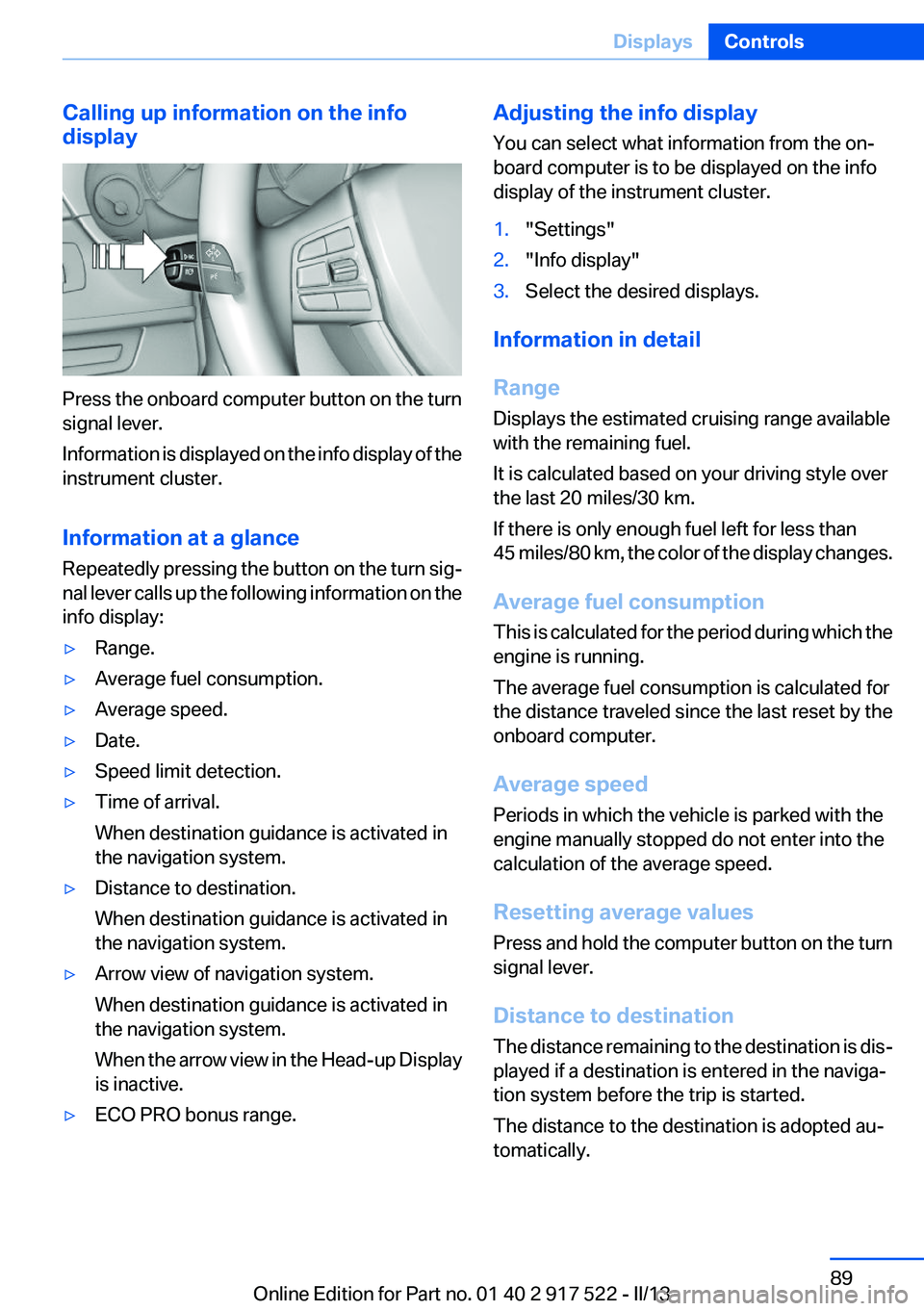
Calling up information on the info
display
Press the onboard computer button on the turn
signal lever.
Information is displayed on the info display of the
instrument cluster.
Information at a glance
Repeatedly pressing the button on the turn sig‚Äź
nal lever calls up the following information on the
info display:
‚Ė∑Range.‚Ė∑Average fuel consumption.‚Ė∑Average speed.‚Ė∑Date.‚Ė∑Speed limit detection.‚Ė∑Time of arrival.
When destination guidance is activated in
the navigation system.‚Ė∑Distance to destination.
When destination guidance is activated in
the navigation system.‚Ė∑Arrow view of navigation system.
When destination guidance is activated in
the navigation system.
When the arrow view in the Head-up Display
is inactive.‚Ė∑ECO PRO bonus range.Adjusting the info display
You can select what information from the on‚Äź
board computer is to be displayed on the info
display of the instrument cluster.1."Settings"2."Info display"3.Select the desired displays.
Information in detail
Range
Displays the estimated cruising range available
with the remaining fuel.
It is calculated based on your driving style over
the last 20 miles/30 km.
If there is only enough fuel left for less than
45 miles/80 km, the color of the display changes.
Average fuel consumption
This is calculated for the period during which the
engine is running.
The average fuel consumption is calculated for
the distance traveled since the last reset by the
onboard computer.
Average speed
Periods in which the vehicle is parked with the
engine manually stopped do not enter into the
calculation of the average speed.
Resetting average values
Press and hold the computer button on the turn
signal lever.
Distance to destination
The distance remaining to the destination is dis‚Äź
played if a destination is entered in the naviga‚Äź
tion system before the trip is started.
The distance to the destination is adopted au‚Äź
tomatically.
Seite 89DisplaysControls89
Online Edition for Part no. 01 40 2 917 522 - II/13
Page 96 of 246
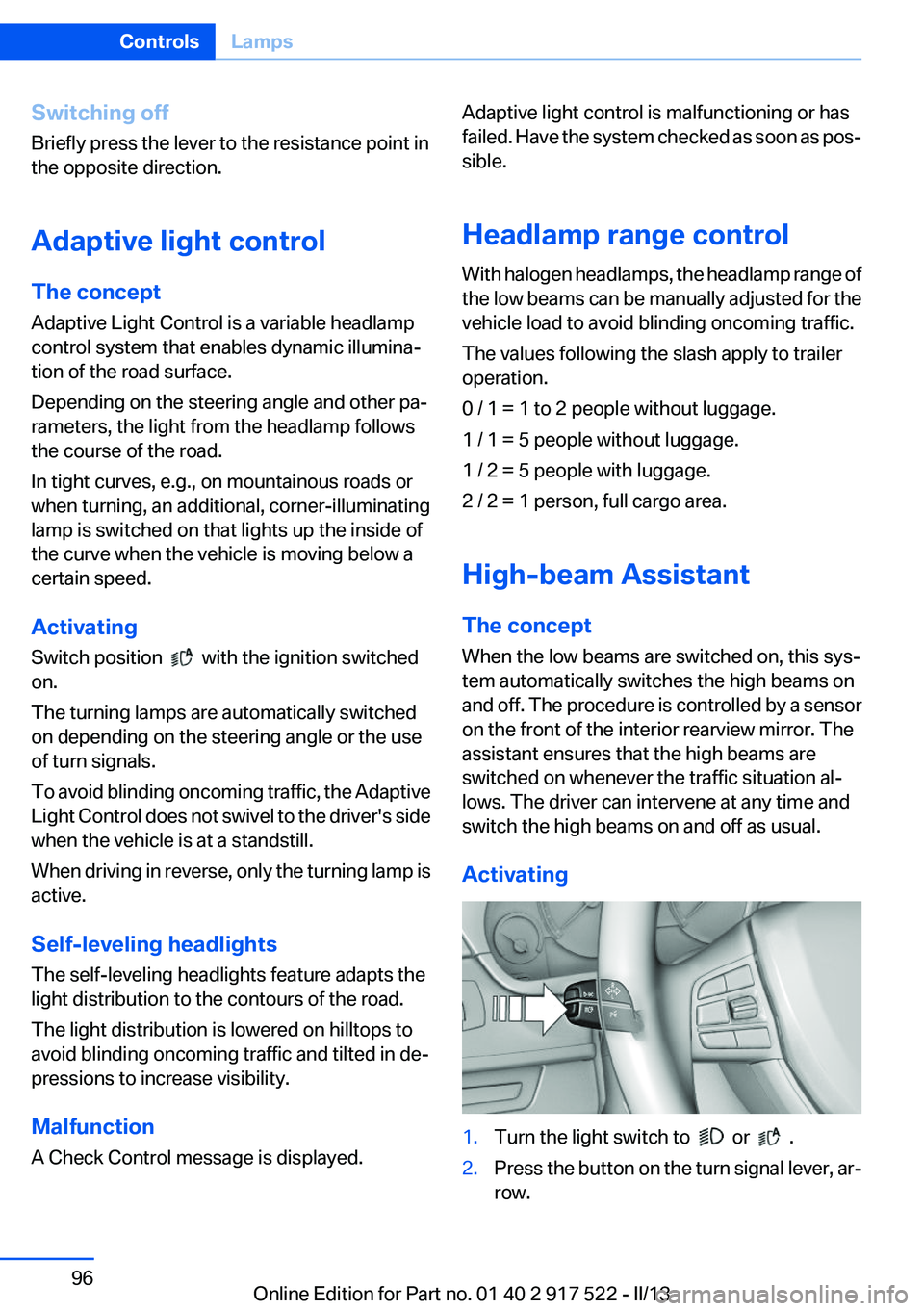
Switching off
Briefly press the lever to the resistance point in
the opposite direction.
Adaptive light control
The concept
Adaptive Light Control is a variable headlamp
control system that enables dynamic illumina‚Äź
tion of the road surface.
Depending on the steering angle and other pa‚Äź
rameters, the light from the headlamp follows
the course of the road.
In tight curves, e.g., on mountainous roads or
when turning, an additional, corner-illuminating
lamp is switched on that lights up the inside of
the curve when the vehicle is moving below a
certain speed.
Activating
Switch position
with the ignition switched
on.
The turning lamps are automatically switched
on depending on the steering angle or the use
of turn signals.
To avoid blinding oncoming traffic, the Adaptive
Light Control does not swivel to the driver's side
when the vehicle is at a standstill.
When driving in reverse, only the turning lamp is
active.
Self-leveling headlights
The self-leveling headlights feature adapts the
light distribution to the contours of the road.
The light distribution is lowered on hilltops to
avoid blinding oncoming traffic and tilted in de‚Äź
pressions to increase visibility.
Malfunction
A Check Control message is displayed.
Adaptive light control is malfunctioning or has
failed. Have the system checked as soon as pos‚Äź
sible.
Headlamp range control
With halogen headlamps, the headlamp range of
the low beams can be manually adjusted for the
vehicle load to avoid blinding oncoming traffic.
The values following the slash apply to trailer
operation.
0 / 1 = 1 to 2 people without luggage.
1 / 1 = 5 people without luggage.
1 / 2 = 5 people with luggage.
2 / 2 = 1 person, full cargo area.
High-beam Assistant
The concept
When the low beams are switched on, this sys‚Äź
tem automatically switches the high beams on
and off. The procedure is controlled by a sensor
on the front of the interior rearview mirror. The
assistant ensures that the high beams are
switched on whenever the traffic situation al‚Äź
lows. The driver can intervene at any time and
switch the high beams on and off as usual.
Activating1.Turn the light switch to or .2.Press the button on the turn signal lever, ar‚Äź
row.Seite 96ControlsLamps96
Online Edition for Part no. 01 40 2 917 522 - II/13
Page 97 of 246
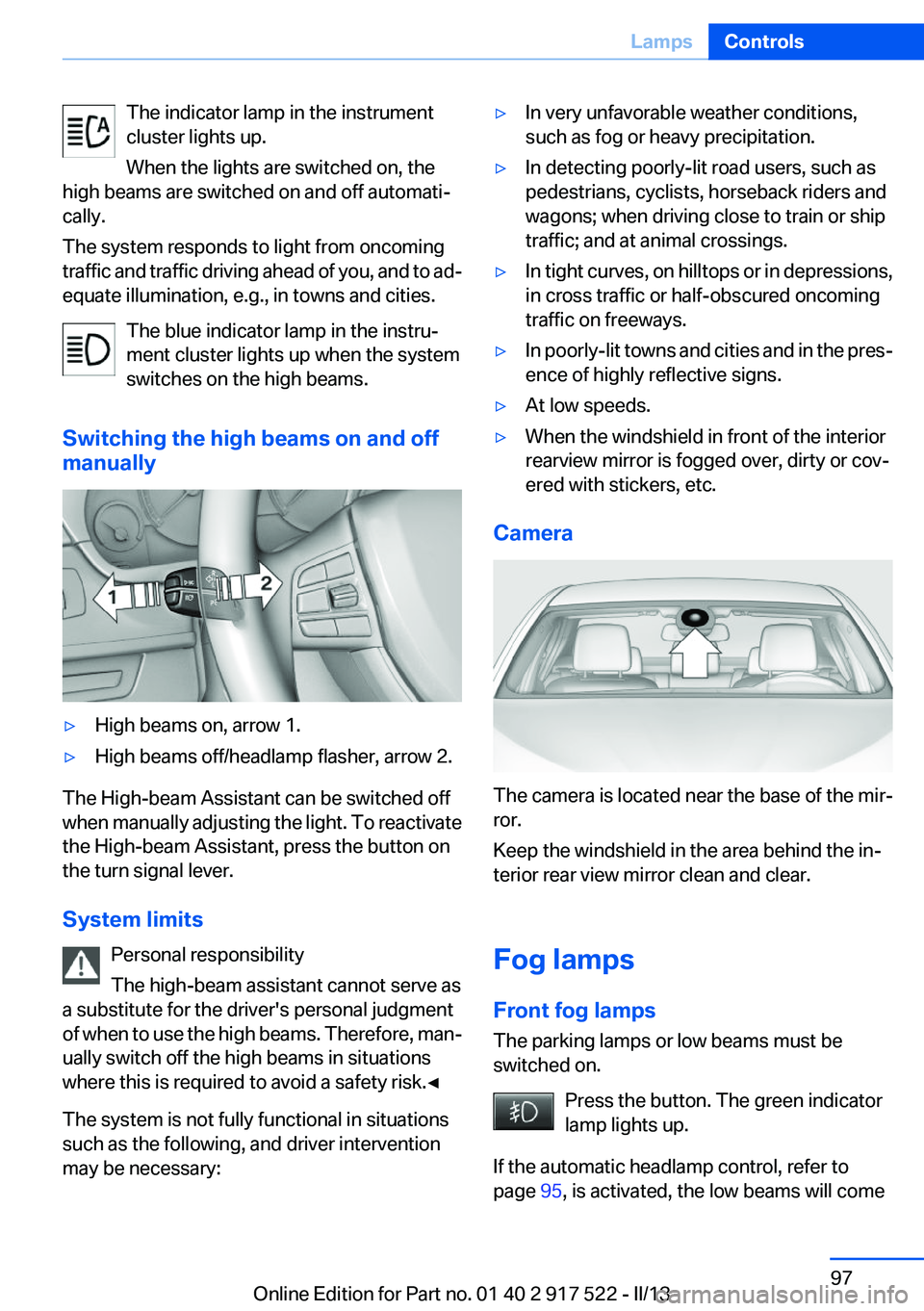
The indicator lamp in the instrument
cluster lights up.
When the lights are switched on, the
high beams are switched on and off automati‚Äź
cally.
The system responds to light from oncoming
traffic and traffic driving ahead of you, and to ad‚Äź
equate illumination, e.g., in towns and cities.
The blue indicator lamp in the instru‚Äź
ment cluster lights up when the system
switches on the high beams.
Switching the high beams on and off
manually‚Ė∑High beams on, arrow 1.‚Ė∑High beams off/headlamp flasher, arrow 2.
The High-beam Assistant can be switched off
when manually adjusting the light. To reactivate
the High-beam Assistant, press the button on
the turn signal lever.
System limits Personal responsibility
The high-beam assistant cannot serve as
a substitute for the driver's personal judgment
of when to use the high beams. Therefore, man‚Äź
ually switch off the high beams in situations
where this is required to avoid a safety risk.‚óÄ
The system is not fully functional in situations
such as the following, and driver intervention
may be necessary:
‚Ė∑In very unfavorable weather conditions,
such as fog or heavy precipitation.‚Ė∑In detecting poorly-lit road users, such as
pedestrians, cyclists, horseback riders and
wagons; when driving close to train or ship
traffic; and at animal crossings.‚Ė∑In tight curves, on hilltops or in depressions,
in cross traffic or half-obscured oncoming
traffic on freeways.‚Ė∑In poorly-lit towns and cities and in the pres‚Äź
ence of highly reflective signs.‚Ė∑At low speeds.‚Ė∑When the windshield in front of the interior
rearview mirror is fogged over, dirty or cov‚Äź
ered with stickers, etc.
Camera
The camera is located near the base of the mir‚Äź
ror.
Keep the windshield in the area behind the in‚Äź
terior rear view mirror clean and clear.
Fog lamps
Front fog lamps
The parking lamps or low beams must be
switched on.
Press the button. The green indicator
lamp lights up.
If the automatic headlamp control, refer to
page 95, is activated, the low beams will come
Seite 97LampsControls97
Online Edition for Part no. 01 40 2 917 522 - II/13
Page 114 of 246
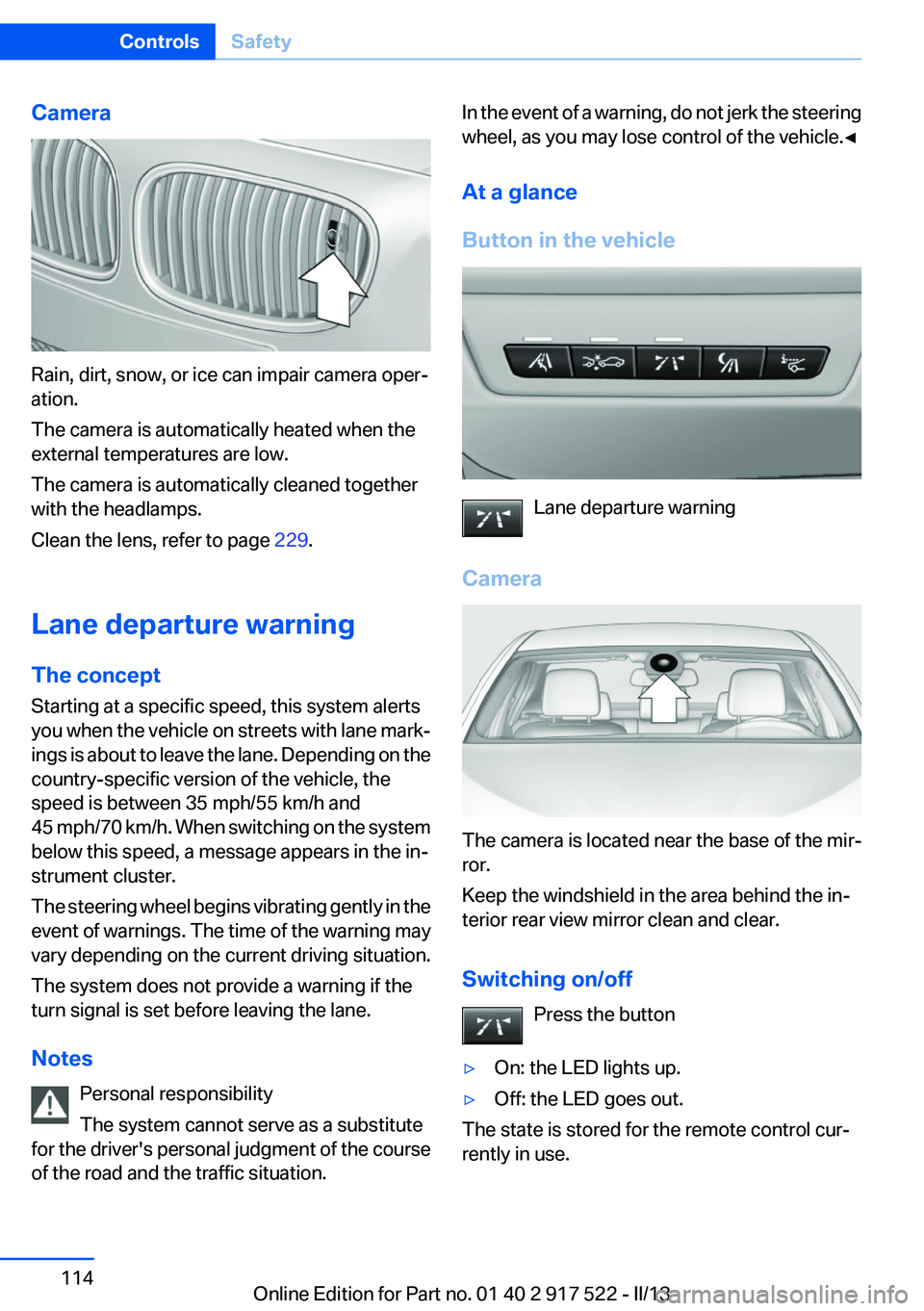
Camera
Rain, dirt, snow, or ice can impair camera oper‚Äź
ation.
The camera is automatically heated when the
external temperatures are low.
The camera is automatically cleaned together
with the headlamps.
Clean the lens, refer to page 229.
Lane departure warning
The concept
Starting at a specific speed, this system alerts
you when the vehicle on streets with lane mark‚Äź
ings is about to leave the lane. Depending on the
country-specific version of the vehicle, the
speed is between 35 mph/55 km/h and
45 mph/70 km/h. When switching on the system
below this speed, a message appears in the in‚Äź
strument cluster.
The steering wheel begins vibrating gently in the
event of warnings. The time of the warning may
vary depending on the current driving situation.
The system does not provide a warning if the
turn signal is set before leaving the lane.
Notes Personal responsibility
The system cannot serve as a substitute
for the driver's personal judgment of the course
of the road and the traffic situation.
In the event of a warning, do not jerk the steering
wheel, as you may lose control of the vehicle.‚óÄ
At a glance
Button in the vehicle
Lane departure warning
Camera
The camera is located near the base of the mir‚Äź
ror.
Keep the windshield in the area behind the in‚Äź
terior rear view mirror clean and clear.
Switching on/off Press the button
‚Ė∑On: the LED lights up.‚Ė∑Off: the LED goes out.
The state is stored for the remote control cur‚Äź
rently in use.
Seite 114ControlsSafety114
Online Edition for Part no. 01 40 2 917 522 - II/13